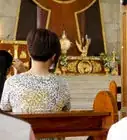wikiHow is a “wiki,” similar to Wikipedia, which means that many of our articles are co-written by multiple authors. To create this article, 43 people, some anonymous, worked to edit and improve it over time.
wikiHow marks an article as reader-approved once it receives enough positive feedback. In this case, 91% of readers who voted found the article helpful, earning it our reader-approved status.
This article has been viewed 301,225 times.
Learn more...
The Holy rosary is a set of prayer beads used to perform a special type of Christian prayer. The Holy rosary is generally associated with Roman Catholic tradition, though other Christian churches are known to occasionally use it as well. While it is not necessary to be a Catholic to pray the Holy Rosary, it is important to remember that the Holy Rosary is a form of devotion with a long, rich history and should be treated with respect. Properly used, the Holy Rosary is a tool for gentle meditation and prayer, allowing one to praise God while reflecting on events in the life of Jesus and Mary.
Steps
Sample Holy Rosary Prayer Text
Reciting the Holy Rosary
-
1Begin by holding the crucifix in your fingers while making the Sign of the Cross. The rosary is said by traveling around the loop of beads, stopping at each one, and saying a prayer. Typically, if someone is going to say the whole rosary, rather than just a section of it, s/he starts with the crucifix at the "bottom".
-
2Say the Apostle's Creed. This prayer is a statement of Christian belief, one that essentially summarizes the things that all Christians believe, including the existence of God, Jesus, the Holy Spirit, and the Resurrection.
- The words of the Apostles' Creed are: "I believe in God, the Father Almighty, Creator of heaven and earth; and in Jesus Christ, His only Son, our Lord: Who was conceived by power of the Holy Spirit, born of the Blessed Virgin Mary; suffered under Pontius Pilate, was crucified, died and was buried. He descended into hell; the third day He rose again from the dead; He ascended into heaven, is seated at the right hand of God the Father Almighty; from thence He shall come to judge the living and the dead. I believe in the Holy Spirit, the Holy Catholic Church, the communion of Saints, the forgiveness of sins, the resurrection of the body, and life everlasting. Amen."
- When Protestants say the Apostle's Creed, they usually change the meaning of the word "Catholic" in the line "I believe in the Holy Spirit, the holy Catholic Church, the communion of saints..." to reflect the concept of universality, rather than the actual earthly institution of the Roman Catholic church.
Advertisement -
3Move to the first bead after the crucifix and say the Lord's Prayer. Take the next bead in your fingers and say the Lord's prayer (also called the "Our Father"). This prayer was passed directly from Jesus to his disciples as a way of expressing devotion to God in heaven.
- The words of the Our Father are: "Our Father, Who art in Heaven, hallowed be Thy Name. Thy Kingdom come, Thy Will be done, on earth as it is in Heaven. Give us this day our daily bread, and forgive us our trespasses as we forgive those who trespass against us. And lead us not into temptation, but deliver us from evil. Amen."
-
4Move to the following group of three beads and say three Hail Marys. Next, say one Hail Mary for each of the next three beads, taking each bead in your fingers as you begin each prayer in succession. Traditionally, among Catholics, these 3 Hail Marys are offered to obtain an increase in the virtues of Faith, Hope and Charity and for the intentions of the Pope.
- The words of the Hail Mary are: "Hail Mary, full of grace, the Lord is with thee. Blessed art thou among women, and blessed is the fruit of thy womb, Jesus. Holy Mary, Mother of God, pray for us sinners, now and at the hour of our death. Amen."
- Some Protestants are hesitant to say the Hail Mary because it is offered to Mary, rather than God or Jesus. Though it's up to you to decide whether you want to say the Hail Mary or not, the many arguments put forth by members of the Catholic Church and various Protestant churches[1]
regarding the prayer's biblical basis may help you come to a decision.
- If you're reluctant to say the Hail Mary, know that some Protestant churches have their own versions of the rosary that omit this prayer.
-
5Move to the chain or cord between the three Hail Mary beads and the next bead and say the Doxology. The Doxology (also called the "Glory Be to the Father" or "Gloria Patri") is a short hymn of praise exulting God, Jesus, and the Holy Spirit.
- The words of the Doxology are: "Glory be to the Father, and to the Son, and to the Holy Ghost. As it was in the beginning, is now, will be for ever. Amen."
- Often, if the Holy rosary is made from string, rather than chain, the Doxology will be marked with a thick or knotted section.
-
6Proceed to the next bead and say an Our Father. This bead, which is usually a large and/or decorative medallion, marks the beginning of the first "decade" of the Holy rosary. The Holy rosary is divided into five decades, each composed of ten Hail Marys and separated from each other by Our Fathers.
-
7Say the first decade by reciting the "Hail Mary" for each bead in the decade. After the central bead, move counter-clockwise to the first group of ten beads. Say one Hail Mary for each bead in the decade, moving along the length of beads as you go.
- Note that many people say a single decade of the Holy rosary as a "short version" of the Holy rosary when they don't have time to say the entire Holy rosary.
-
8Proceed to the chain or cord separating the first decade from the next bead and say the Doxology. Optionally, you can also add the Fátima Prayer or/and the prayer for priests at this point; this is done without moving along the beads.
- The words of the Fátima Prayer are: "O my Jesus, forgive us our sins, save us from the fires of hell. Lead all souls to heaven, especially those in most need of Thy mercy."
- The words of the prayer for priests are: "O Jesus, our great High Priest, hear my humble prayers on behalf of your priests. Give them a deep faith, a bright and firm hope and a burning love which will ever increase in the course of their priestly life. In their loneliness, comfort them. In their sorrows, strengthen them. In their frustrations, point out to them that it is through suffering that the soul is purified, and show them that they are needed by the Church; they are needed by souls; they are needed for the work of redemption."
-
9Proceed through the next decade, starting with the Lord's Prayer. You have successfully completed the first decade of the Holy rosary. Now, continue along the Holy rosary's beads, following the pattern of the first decade for each subsequent decade - one Our Father for the first bead, followed by a Hail Mary for each of the following ten beads, followed by a Doxology. Work your way along the rosary in this fashion until you have gone all the way around the chain of beads and are back at the large central bead.
-
10Reach the center medallion and say the Salve Regina. The Salve Regina is a hymn extolling the Blessed Virgin Mary similar to the Hail Mary. When you finish, make the Sign of the Cross to finish the Holy Rosary. Congratulations - you're done!
- The words of the "Salve Regina" Hail Holy Queen or are: "Hail Holy Queen, Mother of Mercy, our life, our sweetness, and our hope. To thee do we cry, poor banished children of Eve; to thee do we send up our sighs, mourning and weeping in this vale of tears. Turn then, most gracious advocate, thine eyes of mercy toward us, and after this, our exile, show unto us the blessed fruit of thy womb, Jesus. O clement, O loving, O sweet Virgin Mary! Pray for us, O Holy Mother of God, that we may be made worthy of the promises of Christ."
- Catholic tradition dictates that, if you like, you may add any prayers at the end of the Holy rosary that you like. These can be "official" prayers like the Our Father and Apostle's Creed or personal, improvised prayers from the heart.
Saying the Mysteries of the Rosary
-
1Use the mysteries to deepen your relationship with Christ and Mary. The Holy rosary is not just a prayer tool - it's also a way to reflect on important events in the lives of Jesus and Mary. Many serious Catholics choose to do so by reflecting on certain sets of mysteries as they pray the Holy rosary. Each set contains five mysteries grouped according to certain emotional themes. Individual mysteries are events in the life of Jesus and/or Mary that are taken from the Bible. Each mystery is associated with a certain religious virtue or "spiritual fruit" (e.g. charity, patience, etc.). By reflecting on these mysteries, someone who prays the Holy rosary can work to strengthen his or her personal relationship with Jesus and and Mary, meditating on each event and the spiritual fruit associated with it. Note that not everyone who says the rosary chooses to do this, but anyone can.
- There are currently four sets of mysteries. The fourth mystery was added by Pope John Paul II in 2002; the others are centuries old.[2]
The sets of mysteries are:
- The Joyful Mysteries
- The Sorrowful Mysteries
- The Glorious Mysteries
- The Luminous Mysteries (added by Pope Saint John Paul II in 2002)
- There are currently four sets of mysteries. The fourth mystery was added by Pope John Paul II in 2002; the others are centuries old.[2]
The sets of mysteries are:
-
2Reflect on one mystery for each decade of the rosary. To say the rosary in observance of one of the sets of mysteries, the person saying the rosary proceeds as normal from the crucifix through the first few beads. When s/he reaches the first decade, s/he meditates on the first mystery as s/he prays the Our Father, the ten Hail Marys, and so on. Upon reaching the second decade, s/he meditates on the second mystery as s/he prays. The person saying the rosary proceeds through the rosary in this fashion, reflecting on a different mystery for each decade. Each set of mysteries contains five mysteries - one for each decade of the rosary.
- Traditionally, a person reflects on a different set of mysteries for each day of the week. Below are more detailed instructions for each set.
-
3Reflect on the Five Joyful Mysteries on Mondays, Saturdays, and Sundays during Advent. The Joyful Mysteries are happy events in the lives of Jesus and Mary. These events occur fairly early in their respective stories - two even take place before the birth of Jesus. The Joyful Mysteries and the spiritual fruits associated with each are listed below:
- The Annunciation: Humility
- The Visitation: Charity
- The Birth of Our Lord: Poverty, or Detachment from the world
- The Presentation of Our Lord: Purity of heart; Obedience
- The Finding of Our Lord in the Temple: Piety
-
4Reflect on the Five Sorrowful Mysteries on Tuesday, Friday, and Sundays during Lent. The Sorrowful Mysteries are sad events in the lives of Jesus and Mary (especially Jesus). These events are centered around the death of Christ by crucifixion. The Sorrowful Mysteries and the spiritual fruits associated with each are listed below:
- The Agony in the Garden: Contrition for our sins
- The Scourging at the Pillar: Mortification of our senses
- The Crowning with Thorns: Interior mortification
- The Carrying of the Cross: Patience under crosses
- The Crucifixion and Death of Our Lord: That we may die to ourselves
-
5Reflect on the Five Glorious Mysteries on Wednesdays and Sundays in Ordinary Time. The Glorious Mysteries are events associate with the resurrection of Christ and the entry of Jesus and his mother into heaven. The Glorious Mysteries and the spiritual fruits associated with each are listed below:
- The Resurrection: Conversion of heart
- The Ascension: A desire for heaven
- The Coming of the Holy Ghost: The Gifts of the Holy Ghost
- The Assumption of our Blessed Mother into Heaven: Devotion to Mary
- The Coronation of our Blessed Mother: Eternal happiness
-
6Reflect on the Five Luminous Mysteries on Thursdays. The Luminous Mysteries are the most-recently created mysteries, having been added to Catholic tradition in 2002. These mysteries are events from Jesus' adult life and ministry. Unlike the other sets of mysteries, the Luminous Mysteries are not necessarily close to each other chronologically - while, for instance, the Sorrowful Mysteries all take place in sequence during a single short period, the Luminous Mysteries do not. The Luminous Mysteries and the spiritual fruits associated with each are listed below:
- The Baptism of Jesus in the Jordan: Openness to the Holy Spirit, the Healer.
- The Wedding at Cana: To Jesus through Mary. The understanding of the ability to manifest-through faith.
- Jesus' Proclamation of the Kingdom of God: Trust in God (Call of Conversion to Messiah)
- The Transfiguration: Desire for Holiness
- The Institution of the Eucharist: Adoration
Community Q&A
-
QuestionWho discovered the Holy Rosary?
 Community AnswerMost people attribute the Holy Rosary to Saint Dominic. But it more than likely evolved from repeating the Ave Maria (Hail Mary) and other Marion prayers.
Community AnswerMost people attribute the Holy Rosary to Saint Dominic. But it more than likely evolved from repeating the Ave Maria (Hail Mary) and other Marion prayers. -
QuestionWhere do I place my personal intentions when praying the rosary?
 Community AnswerSome pray personal intentions before starting the Apostles' Creed at the very beginning of the rosary. Some people pray each decade for a specific intention; if you want to do that, pray your personal intention before the Our Fathers for each decade.
Community AnswerSome pray personal intentions before starting the Apostles' Creed at the very beginning of the rosary. Some people pray each decade for a specific intention; if you want to do that, pray your personal intention before the Our Fathers for each decade. -
QuestionDo I have to say the Mysteries while saying the rosary?
 Community AnswerNo, that's optional. Just following Method 1 is enough.
Community AnswerNo, that's optional. Just following Method 1 is enough.
Warnings
- Don't worry about making mistakes; God understands.⧼thumbs_response⧽
- Some people will tell you it is not proper to pray a Rosary to help yourself fall asleep at night. This is a mistake, as the practise is perfectly acceptable. What better way to fall asleep than with the words of these lovely prayers in your mind? Saint Bernadette Soubirous, the visionary of Our Lady of Lourdes, actually recommended this practice and said, "It's like a little child going to sleep saying 'Mama, Mama.'" There is also the traditional belief that your guardian angel finishes the Rosary for you after you fall asleep.⧼thumbs_response⧽
- In addition to meditating on events from the lives of Jesus and Mother Mary, you can also offer the Rosary decades for prayer intentions. These can range from asking for an increase of grace to practice a virtue illustrated by the mystery, a prayer for a group of people (homeless, poor, elderly, victims of abortion, etc.) or any other valid intention that you wish.⧼thumbs_response⧽
- The Church has a tradition of "indulgences" and in this tradition, the Rosary is an "indulgenced" prayer. This simply means that when prayed with purity of heart and love for God, without attachment to sin, the prayer obtains for you a partial remission of temporal punishment due to sins you have committed. This indulgence can be given by you to the Holy Souls in purgatory but not to any other living person. For a more in-depth explanation of this, search online, especially at New Advent, which has an excellent Catholic encyclopedia. Don't become obsessed with piling up Rosary sessions. Saints who wrote about the Rosary said that sheer numbers are less impressive to God than quality. One Rosary thoughtfully and lovingly prayed outweighs a hundred prayed badly.⧼thumbs_response⧽
- Pray effectually. "And when you pray, use no vain repetitions, as the heathen do: for they think that they shall be heard for their much speaking." (Matthew 6:7)[3] . Believe and accept that God already knows your needs, prayers and cares...⧼thumbs_response⧽
Things You'll Need
- A Rosary, a set of beads on a chain or cord, available at any Catholic supply store, physical or online. Your ten fingers can also work, as are 'rosary cards' (plastic cards with the rosary beads embossed on them) or ring rosaries.
- A pamphlet or prayer book (also found in Catholic stores) explaining the prayers and the Mysteries (meditations) that are involved in the Rosary; or a good website, preferably illustrated.
- You will, in the end, need to take care and pray in peace.
References
- ↑ http://www.gotquestions.org/Hail-Mary.html
- ↑ http://www.loyolapress.com/mysteries-of-the-rosary.htm
- ↑ "And when you pray, use no vain repetitions, as the heathen do: for they think that they shall be heard for their much speaking."(Matthew 6:7)
- http://www.rosary-center.org/howto.htm Diagram and explanation of the prayers and Mysteries, illustrated.
- http://www.rosaryarmy.com/ Offers one free twine rosary per household.
About This Article
To recite the Holy Rosary, hold a crucifix in your fingers while making the sign of the cross. Recite the Apostle’s Creed, then move your fingers to the first bead on the rosary and say the Lord’s Prayer. Say one Hail Mary for each of the next 3 beads, then move your fingers to the string on the other side of the Hail Mary beads and say the Doxology. Move to the next bead and say Our Father, then say a Hail Mary for each of the next 10 beads, followed by the Doxology, another Our Father, and 10 more Hail Marys. When you reach the center medallion, say the Salve Regina and make the sign of the cross to finish. To learn more about the exact words to say while you recite the Holy Rosary, keep reading!

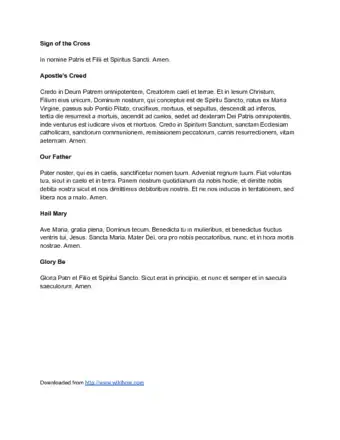
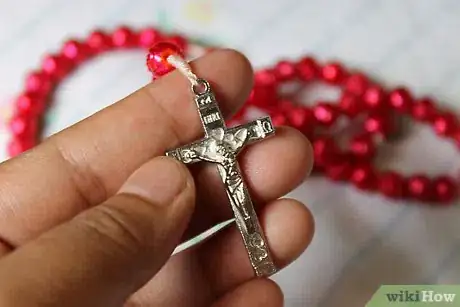

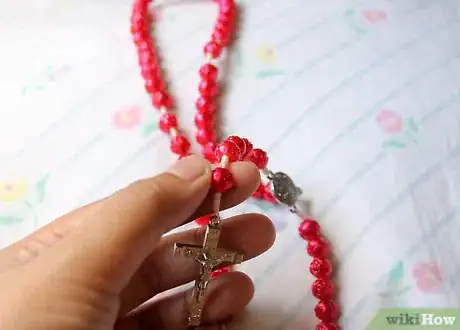
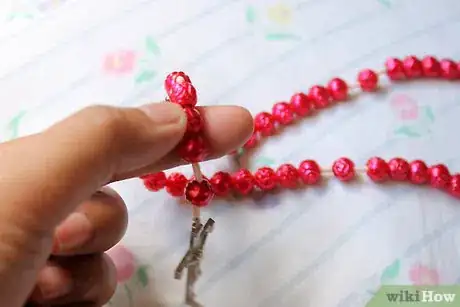
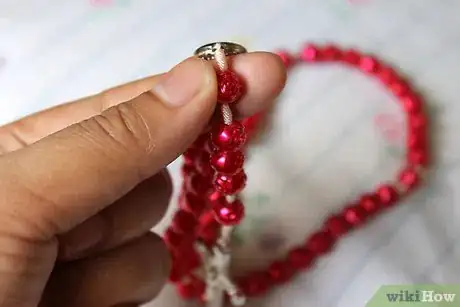
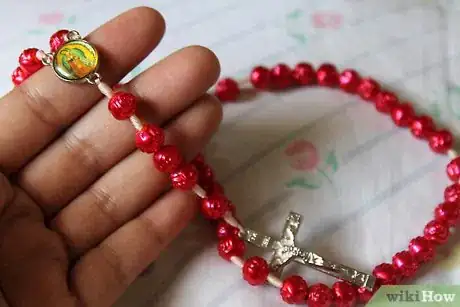

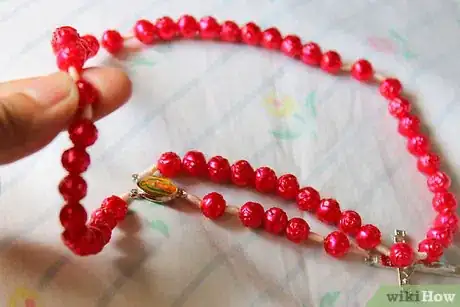
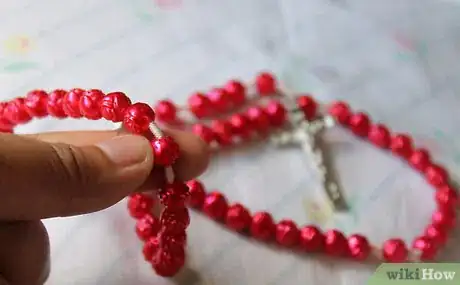


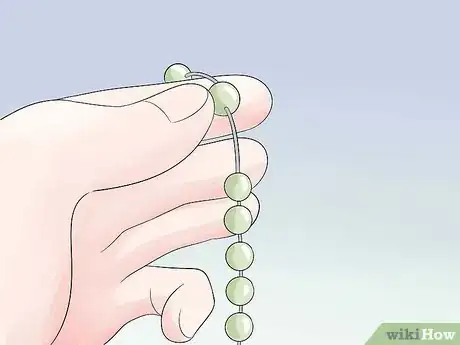

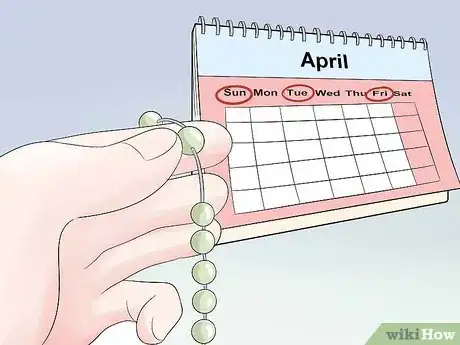
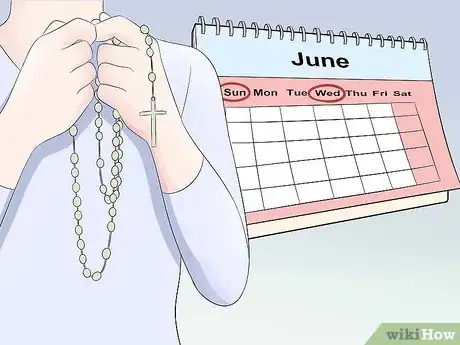
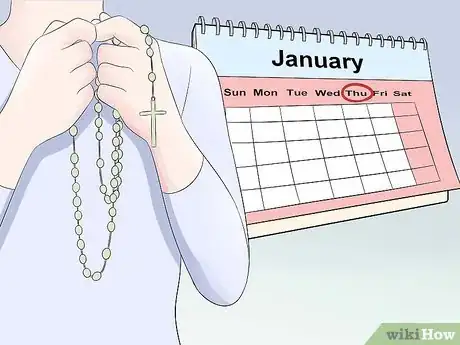
-Step-18.webp)




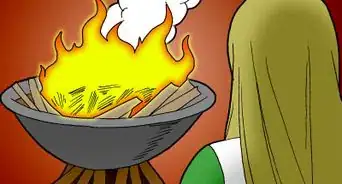

















-Step-18.webp)


